Eco-Friendly Lawn Care in Colorado: Save Water, Save Money, Save Your Yard
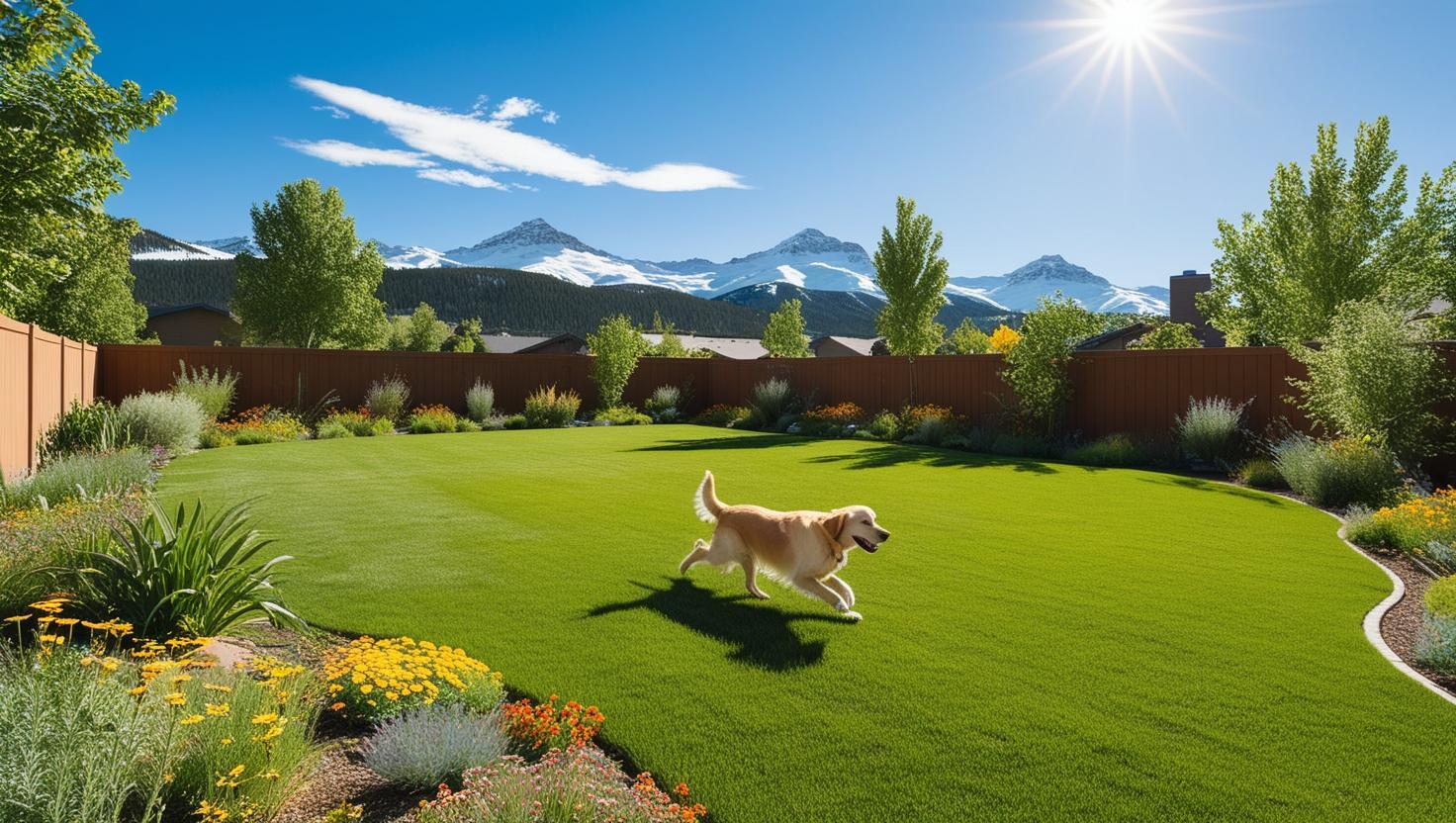
Why Eco-Friendly Lawn Care Matters in Colorado
Living in Colorado means dealing with beauty—and challenges.
Our high altitude, low rainfall, and intense sunshine can be brutal on traditional lawns.
A standard green lawn often guzzles thousands of gallons of water every summer.
Add chemical fertilizers and pesticides to the mix, and you’re looking at serious environmental strain—not to mention high bills.
Eco-friendly lawn care offers a better way:
- Healthier soil
- Lower water use
- Safe spaces for kids and pets
- Reduced pollution in our rivers and lakes
Most importantly, it helps preserve Colorado’s natural beauty for future generations.
Whether you’re a new homeowner or you’ve lived here for years, switching to eco-friendly methods is one of the best choices you can make for your yard—and the planet.
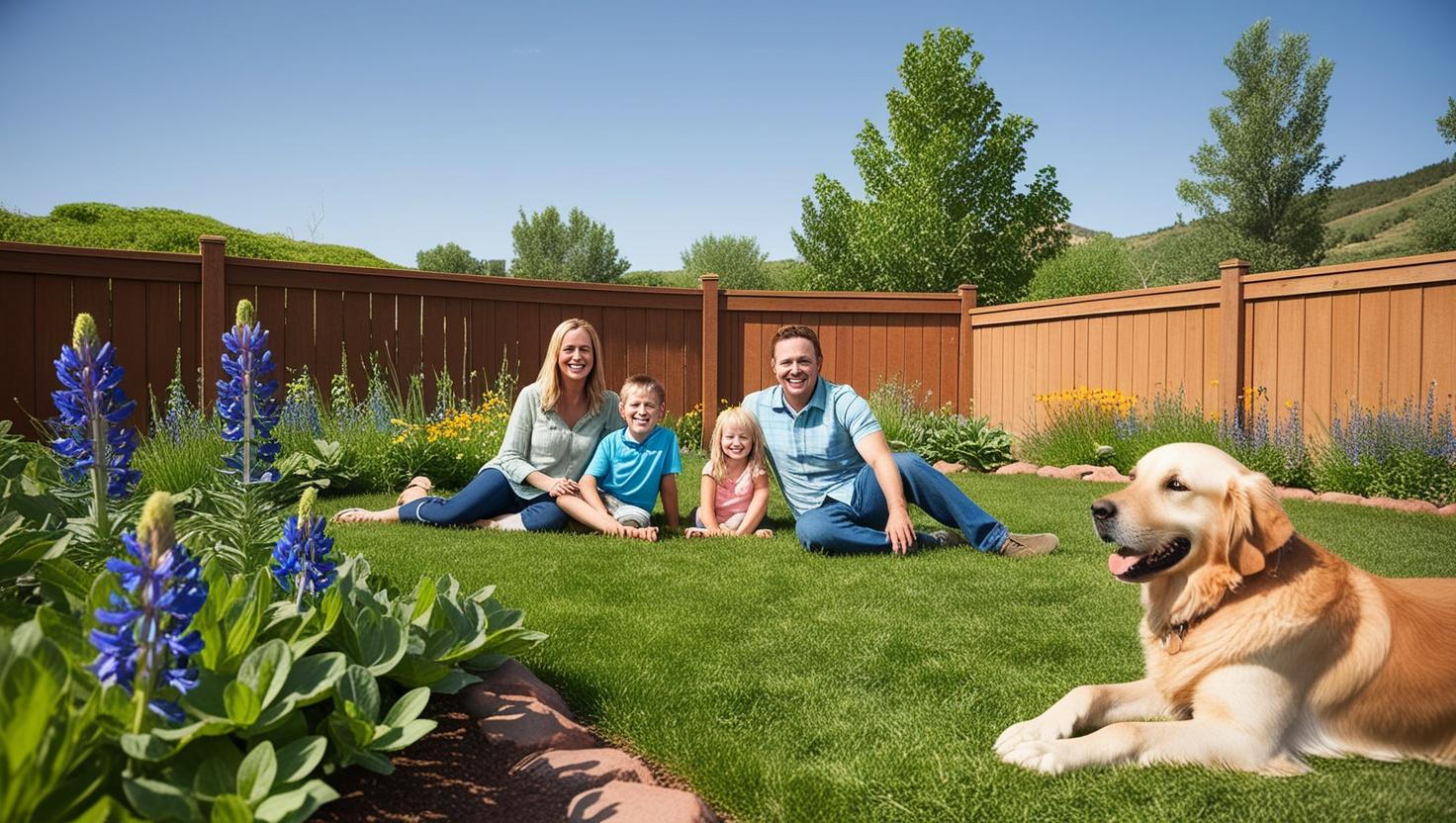
Common Questions About Eco-Friendly Lawn Care
Can I still have a traditional-looking lawn?
Yes! Eco-friendly doesn’t mean wild or messy. It just means smarter, healthier practices.
Is it more expensive?
Some eco-friendly products cost more upfront. But the savings on water, chemicals, and replanting add up fast.
Will my lawn survive Colorado winters?
Absolutely. In fact, eco-friendly lawns with strong roots often bounce back better after harsh winters.
Do I need special equipment?
Not always. Many changes (like watering smarter or using compost) require little or no new gear.
How soon will I see results?
Many homeowners notice greener, healthier grass within just one season of switching to eco-friendly care.
Step 1: Choose the Right Grass
The secret to a successful eco-friendly lawn starts with what you plant.
Top Grasses for Colorado’s Climate
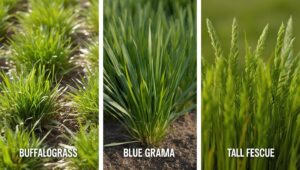
Buffalograss
- Native to the Great Plains.
- Needs 60–70% less water than traditional turf.
- Grows only 4–6 inches tall—less mowing!
Blue Grama
- Colorado’s official state grass.
- Tolerates drought and poor soil.
- Soft, fine texture that feels great barefoot.
Tall Fescue
- Deep root systems that find moisture underground.
- Stays green longer into fall compared to Kentucky Bluegrass.
- Works well for high-traffic areas.
How to Pick the Right Grass for You
- Full Sun: Buffalograss thrives.
- Partial Shade: Tall fescue does better.
- Low Maintenance: Blue grama keeps things simple.
You can even blend species for a custom look and performance that fits your yard’s sun patterns and soil type.
Pro Tip: Ask your lawn care provider about custom seed blends made for Colorado’s Front Range or mountain zones!
Step 2: Water Smarter, Not Harder
In Colorado, over 50% of residential water use goes to lawns.
That’s a huge opportunity to save.
Install a Smart Irrigation System
A smart sprinkler controller connects to Wi-Fi and uses weather forecasts to adjust watering automatically.
Rain in the forecast? It skips the cycle. Hot dry streak? It adds a little extra.
Popular options:
- Rachio Smart Sprinkler
- Orbit B-Hyve
- Hunter Hydrawise
Bonus: Some water utilities offer rebates if you install one!
Best Watering Techniques for Colorado Lawns
- Water between 5 a.m. and 8 a.m. to minimize evaporation.
- Aim for 1–1.5 inches of water per week (depending on weather).
- Water deeply, not daily — long, deep watering sessions encourage stronger roots.
Think of it like training your lawn to “drink deeper” instead of relying on frequent sips.
DIY Tip: How to Measure Water
Place an empty tuna can on your lawn during a watering session.
When the can is full, you’ve hit about 1 inch of water.
Simple, free, and surprisingly effective!
Step 3: Feed Your Lawn Naturally
Healthy soil equals healthy grass.
Ditching synthetic fertilizers doesn’t mean your lawn starves.
It actually thrives with natural methods.
Compost: Nature’s Miracle
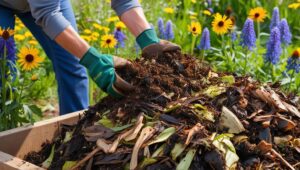
Compost adds essential nutrients back into the soil—no chemicals needed.
How to Start Composting at Home:
- Use a small bin or pile in a shady spot.
- Layer “browns” (leaves, cardboard) and “greens” (food scraps, grass clippings).
- Keep it moist like a wrung-out sponge.
- Turn it weekly with a shovel or pitchfork.
- In a few months, you’ll have rich, earthy compost ready to use!
Adding just a thin ¼-inch layer of compost to your lawn in spring and fall can make a huge difference in soil health.
Organic Fertilizers
Look for brands certified by OMRI (Organic Materials Review Institute).
Common organic ingredients:
- Seaweed extract (boosts growth naturally)
- Bone meal (adds phosphorus for root health)
- Compost tea (a natural liquid fertilizer)
Pro Tip: Apply organic fertilizers in early spring and again in fall for best results.
Grasscycling: The Easiest Win
Instead of bagging grass clippings, leave them on the lawn after mowing.
They break down fast, returning nitrogen and organic matter back into the soil.
Less work + free fertilizer = win-win!
Plus, by grasscycling, you save landfill space and reduce hauling emissions. It’s a small change with a big environmental impact.
Step 4: Rethink Your Lawn Design
You don’t have to say goodbye to your green space.
Just think creatively!
Native Plant Gardens
Colorado native plants are stunning—and tough.
They need less water, fewer chemicals, and attract helpful wildlife.
Great native plants for Colorado yards:
- Rocky Mountain Penstemon (blue-purple blooms)
- Blanketflower (bright red and yellow flowers)
- Serviceberry bushes (beautiful white spring blossoms)
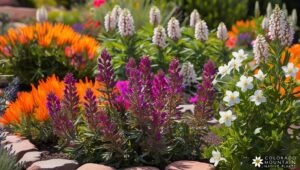
Native gardens also create essential habitat for pollinators like bees, butterflies, and hummingbirds.
Rock Gardens
Rock gardens (also called xeriscapes) combine stones, drought-resistant plants, and colorful mulch for a low-maintenance masterpiece.
Benefits:
- No mowing
- Minimal watering
- Year-round beauty
Rock gardens aren’t just practical—they can be beautiful works of art that reflect Colorado’s natural landscapes.
Mulch Beds
Organic mulch (like wood chips or bark) helps the soil retain moisture, reduces weeds, and keeps roots cooler.
Where to use mulch:
- Around trees
- Flower beds
- Pathways and borders
Mulch also breaks down over time, enriching your soil naturally.

Bonus: Create a Pollinator Paradise
Adding a small pollinator patch with wildflowers like milkweed, bee balm, and coneflowers can support endangered species while beautifying your space.
Tip: Even a small 3×3-foot section can feed dozens of bees, butterflies, and beneficial insects!
Supporting pollinators strengthens the entire local ecosystem—and rewards you with colorful blooms all summer long.
Step 5: Lawn Care Without Harsh Chemicals
Protecting your family, pets, and local pollinators starts with safer lawn care practices.
Safe Weed Control Alternatives
- Pull weeds early (before they seed).
- Use mulch to block weed growth.
- Apply vinegar or boiling water to cracks in sidewalks.
DIY Vinegar Spray:
- 1 gallon of vinegar
- 1 cup salt
- 1 tablespoon dish soap
Spray directly on weeds on sunny days for best results.
Natural Pest Solutions
Keeping pests in check doesn’t have to mean reaching for harsh chemicals. With a little help from nature, you can safely and effectively manage your lawn’s insect population without harming the environment. Here are a few eco-friendly solutions:
- Ladybugs: These little creatures are more than just cute—they’re fierce aphid hunters! A single ladybug can eat up to 50 aphids a day, making them a natural and effective way to protect your plants from these pesky pests.
- Neem oil: Derived from the neem tree, this natural oil is a powerful tool in pest control. It targets harmful insects like aphids, whiteflies, and mites, while leaving beneficial insects like bees and butterflies unharmed. Plus, neem oil is biodegradable and safe for pets and humans!
- Nematodes: These microscopic worms work their magic below the surface, targeting soil-dwelling pests like grubs. When applied to the soil, nematodes invade and kill pests without disrupting your lawn’s ecosystem, giving you a healthier, more balanced garden.
By using these natural solutions, you can keep your lawn pest-free while supporting a healthy, thriving environment for beneficial insects, birds, and pollinators.
Why Chemical-Free Matters
Pesticides and herbicides can kill more than just pests—they harm bees, butterflies, birds, and even pets.
Every time you skip chemicals, you protect Colorado’s rivers, lakes, and wildlife.
Eco-friendly lawns are about creating healthy outdoor spaces for everyone—humans and nature alike.
Bonus Tip: Eco-Friendly Lawn Equipment
Switching to electric or battery-powered lawn equipment can dramatically cut your carbon footprint.
Why It Matters
Traditional gas-powered lawn mowers and blowers emit surprisingly high levels of air pollution.
In fact, running a gas mower for one hour can produce as much pollution as driving a car for 100 miles!
Eco-Friendly Equipment Ideas
- Electric mowers: Quiet, clean, and powerful enough for most residential yards.
- Battery-powered string trimmers and edgers: Lightweight and easy to handle.
- Manual reel mowers: Perfect for small lawns and total zero-emission maintenance.
Pro Tip: Look for brands like EGO, Greenworks, or Ryobi, which offer full electric yard tool lineups.
Partner With a Pro Who Understands Colorado
Going eco-friendly doesn’t mean going it alone.
When you work with a lawn care team that knows Colorado’s challenges, the whole process gets easier—and more successful.
Look for companies who:
- Offer organic treatments
- Prioritize water conservation
- Design with native plants
- Use electric or low-emission mowers and trimmers
At [Your Company Name], we specialize in creating eco-friendly lawns that thrive in Colorado’s unique conditions.
We make it easy, beautiful, and sustainable.
Final Thoughts: Small Changes, Big Results
You don’t have to overhaul your yard overnight.
Every step toward eco-friendly lawn care—switching grasses, watering smarter, skipping chemicals—makes a real difference.
Start small. Dream big.
Together, we can create yards that are beautiful, sustainable, and Colorado-proud.
Ready to Go Green?

Your dream lawn doesn’t have to cost the earth—literally.
With just a few smart, eco-friendly changes, you can have a yard that’s greener, healthier, and way easier to care for.
Whether you’re ready to swap out your thirsty turf, create a pollinator paradise, or just start watering smarter, we’re here to make it simple—and even a little fun!
Imagine stepping outside to a lush, vibrant yard that saves you money, time, and water… all while giving back to Colorado’s beautiful environment.
Let’s build a greener future together, one gorgeous yard at a time.
Give us a call today to schedule your FREE eco-friendly lawn consultation — your dream yard is just one conversation away!